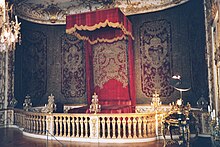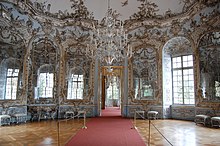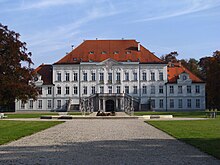Francois de Cuvillies
François de Cuvilliés (23 October 1695 in Soignies, Hainaut - 14 April 1768 in Munich) was a Belgian-born German master builder, sculptor, plasterer, ornament maker and architect. in the service of the Bavarian court, recognized as one of the masters of the Bavarian rococo. He trained in Paris with Jacques François Blondel and attempted to adapt French Rococo to eighteenth-century German taste. His highly ornamental style, rich in plant motifs, spread throughout Europe thanks to a series of engravings published by him starting in 1738, helping to spread the taste and style of Rococo. François de Cuvilliés, sometimes called the Elder, was the father of the architect François Cuvilliés the Younger (1731-1777), who succeeded him at the Bavarian court.
Of his works, the Amalienburg Pavilion in Nymphenburg (1734-1739) and the Rococo jewel of the court theater in the Residence of Munich, named in his honor «Cuvilliés Theatre» stand out.
Biography
Early years and training
Jean François Vincent Joseph Cuvilliés was born on October 23, 1695, in the small town of Soignies in Hainaut County (now Belgium), then part of the Spanish Netherlands, where Prince Elector Maximilian II Emanuel de Bavaria served as Governor General. Cuvilliés was the penultimate in a family of six children.
In 1706, before he was eleven years old, he found a place at the sovereign's court under Msgr. Maximilien-Emmanuel, who had to leave Bavaria in 1704 after the defeat of Hochstatt during the War of the Spanish Succession, maintained during his exile a small court, first in Brussels, then in Mons, where he entertained himself with plays, concerts, and hunts. Cuvilliés was sickly and small in stature, and the Elector Duke made him his court dwarf. He followed the court to Paris, Namur, Compiègne, Saint-Cloud and finally, after the Treaty of Rastatt in April 1715, to Munich.
Cuvilliés, whose talent as a draftsman had already been noticed by the Elector, was appointed draftsman for the court buildings in Munich, under the orders of Joseph Effner (1687-1745), court architect. Like Louis XIV in France, the absolutist ruler of Bavaria had a duty to systematically protect the kingdom's particular talents from him. Thus he made Cuvilliés study mathematics and the art of fortification. Despite his small size, he had him entered in 1717, as a standard bearer, in his regiment. In this way, he found financial support and remained in the closest entourage of Maximiliano Emanuel, for whom he probably had to continue drawing.
From 1720 to 1724 the Elector sent him to Paris to learn about the new architecture and interior decoration of the time and the latest artistic movements, studying at the Académie royale d'architecture. The "style Régence", which owes its name to the regency (1715-1723) of Philippe II of Orleans during the minority of Louis XV and was the predominant style until 1730, was the starting point for the future architectural and decorative creation of Cuvillies. During his stay in Paris, he became familiar with the rules of "distribution" (arrangement of rooms), of "convenience" (correct relationship between the size and degree of decoration of a building, and the rank of its owner) and of "bienséance" (propriety, the correct measure of interior decoration).
Professional Life
Back in Munich, Cuvilliés was able to use his Parisian experiences for the decorative arrangement of Schleissheim Palace, already as a master of buildings, from 1725 as architect of the electoral court under the orders of Joseph Effner, chief master of buildings of the court. Cuvilliés, who was a subordinate of Effner and did not become head of court buildings until 1763, soon surpassed him in influence and it was he who, from 1730 to 1740, under the reign of Elector Carl Albert of Bavaria (r 1726-1745), determined the style at the Munich court, thanks to his great skills as an architect and decorator. Effner and Gunetzrhainer won hardly any commissions. Cuvilliés, who spoke bad German, was not employed in the administration.
Cuvilliés also worked for the brother of the Elector of Bavaria, the Elector Archbishop of Cologne, Clement Augustus of Bavaria. He provided designs for the Augustusburg Palace in Brühl (1728-1740) and built the small Falkenlust Pavilion (1729-1734), both declared (World Heritage Sites). The Falkenlust hunting lodge was established as a pleasure residence and, in contrast to the Augustusburg Palace with its representative claim, gave its rooms a private, homey and intimate character (Chinese lacquer cabinet).
In the Residence in Munich, he created, initially in joint work with Effner, rows of pieces that remain today —despite the destruction of World War II and the restorations that followed until 2001 with original pieces rescued—, now part of the Residence museum: the Gallery of the Ancestors (1726-1730) with the old Treasury Cabinet, today the Porcelain Cabinet (1730-1733), and the apartment of the « Riches Pièces» (apparatus rooms) (1729-1733) with the Green Gallery (1731-1734). With the help of the craftsmen who carried out his projects, Cuvilliés succeeded here, creating masterpieces of interior decoration and, starting from the Regency style, he developed a very specific court style. The South German Rococo was born in the Electoral Residence.
The Amalienburg Pavilion (named after the wife of Prince Elector Carl Albert), built by Cuvilliés between 1734 and 1739 on the grounds of the Nymphenburg Palace park, represents the pinnacle of this early Rococo court style. As the 1911 Encyclopædia Britannica noted, 'His style, though essentially light, is often painfully elaborate and bizarre. He designed mirrors and consoles, balustrades for stairs, ceilings and fireplaces, and especially furniture, beds and chests of drawers ».
The mansions he built at the same time for the nobility reflect that elegant courtly rococo. Unlike the French, he was voluntarily inspired by the country's artists and developed an art of interior decoration where all the decorations increasingly took on a constructive pictorial role, and where ornament won, thanks to its abundance of figured and figurative motifs., with an inexhaustible wealth of forms. In Munich he worked in 1728 at the Palais Piosasque de Non; from 1733 to 1737, in the Palais Holnstein for the residence of Sophia Caroline of Ingenheim, Countess of Holnstein, mistress of Prince-Elector Carl Albert of Bavaria, and from 1743 to 1749 in the reconstruction of Haimhausen Castle, a former Baroque palace from the 17th century XVII for Count Sigmund von Haimhausen, industrialist and politician. In Hesse, he worked at Wilhelmsthal Castle (1743-1761), in Calden, near the city of Kassel, a pleasure palace for the landgrave William VIII of Hesse-Kassel.
Cuvilliés also helped build the collegiate church Marienmünster in Dießen am Ammersee from 1732 to 1739 (director Johann Michael Fischer).
The construction period at the Bavarian court provisionally ended in 1742 when Elector Karl Albert was crowned Holy Roman Emperor. A few days after the coronation, Bavaria was occupied by Austrian troops. In 1745, when Carlos Alberto died, the military, economic and financial situation of the electoral court seemed desperate. However, his successor, Maximilian III Joseph (r. 1745-1777) managed to ratify the separate peace of Füssen in the same year, but only the Treaty of Aix-la-Chapelle (1748) ended the war of succession. austrian During that period of economies there were no major art projects or new buildings, with very few occupations for artists attached to the court; Cuvilliés remained until 1750 without the slightest commission from the court. On the other hand, it was Johann Baptist Gunetzrhainer (1692-1763) and not Cuvilliés who succeeded Effner in 1745, as chief master of the court buildings. The reasons for Cuvillié's resignation were his lack of knowledge of German, his lack of presence in court buildings, and also his apparent aversion to traveling for health reasons. He preferred to be at home and draw.For Cuvilliés, who had not been paid a salary since 1742, the court's financial difficulties were also a problem.
The publication of engravings
During those years, Cuvilliés again dedicated himself intensely to drawing. Between 1738 and 1754 he had published (initially as author-publisher) two series of large-format engravings comprising a total of 50 volumes, each with 6 sheets, on interior decoration of rooms with design elements such as wall panels., ceilings, furniture and decorative objects in wrought iron. For the engraving work, executed from his drawings, he gave preference to his student Karl Albert von Lespilliez (1723-1796). A third series, after 1756, was finished and completed by his son, François Cuvilliés the Younger (1731-1777), who added the representation of some buildings made by his father. With his first volumes, Cuvilliés was not only looking for financial success as a publisher, which unfortunately he did not achieve, but above all a means that would allow him, while allowing him total freedom of artistic expression, to evolve with the Paris artists of the moment, such as Juste-Aurèle Meissonnier (1695-1750), Jacques de Lajoue (1687-1761), Jean Mondon Jr. (died 1749) and many others, who published comparable series of engravings, depicting cartouches and ornaments. intended to serve as models of style. In these ornament books, one sees the development in the 1730s of a new style whose leitmotif was the rocaille form: an asymmetrical, elusive, rhythmic and fluctuating form, based on shells, waterfalls, "C" and "C" curves. S', and bat wings. Sometimes this ornamentation frames whimsical or bucolic scenes, sometimes it replaces architectural frames, or, with its fluid and diffuse forms, it takes the place of architecture with a static structure and geometric outline.
It was thanks to those engravings of ornaments, published in Augsburg, that spread the rocaille style (1730-1745), and, in particular, at the initiative of Cuvilliés, who was one of the first to import rocaille in his engravings, that southern German artists advanced in these new forms and developed a colorful, sometimes fantastical and undoubtedly popular rococo. Here, contrary to French usage, the rocaille form was carved in wood and stucco. By mid-century, ornamentation became the pre-eminent genre and rocaille the most common decoration motif. Influenced both by French examples and by the Bavarian artists around him, while continuing to evolve his previous works, Cuvilliés created at the same time, his own variant of the Rococo style, a very meticulous courtly Rococo, which was able to manifest itself for the first time in construction. of the new opera, commissioned by Prince Elector Maximilian III Joseph (r. 1745-1777).
Cuvilliés Theater and the last years
However, the voter once again turned to Cuvilliés for the construction, starting in 1750, of the Residenztheater after a fire. The theater was destroyed in the war in 1944, but the interior furnishings, which had been relocated during the war, were reinstalled elsewhere in the residence and brought back to life; since then, the old court theater has carried the official name of its architect. The "Cuvilliés Theater" in the Munich Residence, completed in July 1755, remains the main work of this artist.
Shortly before, in 1749, Cuvilliés had made, at the request of the landgrave William VIII of Hesse-Kassel, drawings to erect a new theater for him. Two plans and three watercolor sections are still extant and are kept in the Hesse National Archives in Marburg. Although it was conceived to be about half the size of the Opera House that was built later in Munich, this balconied theater with its central princely box already shows the essential elements of the layout and also includes, in particular, ornament motifs. According to the sketches, the room had to give a very bucolic impression, thanks to the naturalistic framing and the coloring of certain decorative motifs, the flower garlands, for example, which stand out against the white and gold background of the rows of boxes, and thanks to the palm trees that frame the boxes and the rocaille cartridges that crown them. This theater imagined by Cuvilliés was not carried out and its rococo seemed a reprehensible luxury, not suitable for a city marked by Calvinism.
From 1755 to 1756 he incorporated elements of classicism and Italian ornamentation into his works, influenced by the Régence in France during his second stay in Paris and when he attended the architecture school of Jacques-François Blondel. However, he still dominates the Bavarian component, which is why he is counted among the great masters of the German Rococo. The ingenuity of its floor plan solutions, the elegance of its lavish decorations, the combination of whimsy and subtle taste, is second to none. After returning to court in Munich, Cuvilliés was called upon in 1756 to redesign the main building of Nymphenburg Palace. From 1756 he also worked at Sünching Castle. In 1758 he designed the stucco work in the billiard room of the New Palace in Schleissheim.
Around 1759, Cuvilliés drew up a project for the redesign of the Dresden Zwingergarten, including the construction of a new residential palace, which was not realized. Cuvillié's last work was the completion of the façade of the Theatine Church opposite the Residenz in Munich (1765-1768). François de Cuvilliés died in Munich on April 14, 1768.
With the Castrol stove (Castrol Herd) (or Topfherd, pot stove; the name Castrol is derived from the French word casseroles, saucepans), Cuvilliés designed the first stove with a closed hearth and a perforated plate in the roof (installed around 1735 in the Amalienburg kitchen in the park of Nymphenburg Palace).
Works
- Palace of Augustusburg (World Heritage), Brühl (1728-1740)
- Falkenlust Pavilion in Brühl (1729)
- Palace Piosasque de Non in Munich (1729)
- Holnstein Palace in Munich (1733-1737)
- Schäftlarn Abbey Church (1733-1740), completed from 1751 to 1760 by Johann Georg Gunetzrhainer and Johann Michael Fischer.
- Amalienburg Pavilion, Nymphenburg Park (1734-1739)
- Expansion and decoration of the residence of Munich, including the Reichen Zimmer (rich rooms9 (1730-1737)
- Reconstruction of the castle of Haimhausen (1743-1750), an ancient Baroque palace of the centuryXVII reconstructed in the Rococo style, for Count Sigmund von Haimhausen, industrial and political.
- Wilhelmsthal Castle in Calden, near Kassel (1744)
- Cuvilliés Theatre, near the residence of Munich (1751-1753)
- Church of the Teatinos, Munich (1765-1768)
Contenido relacionado
Chen Shui-bian
Silver engraving
Cosey











